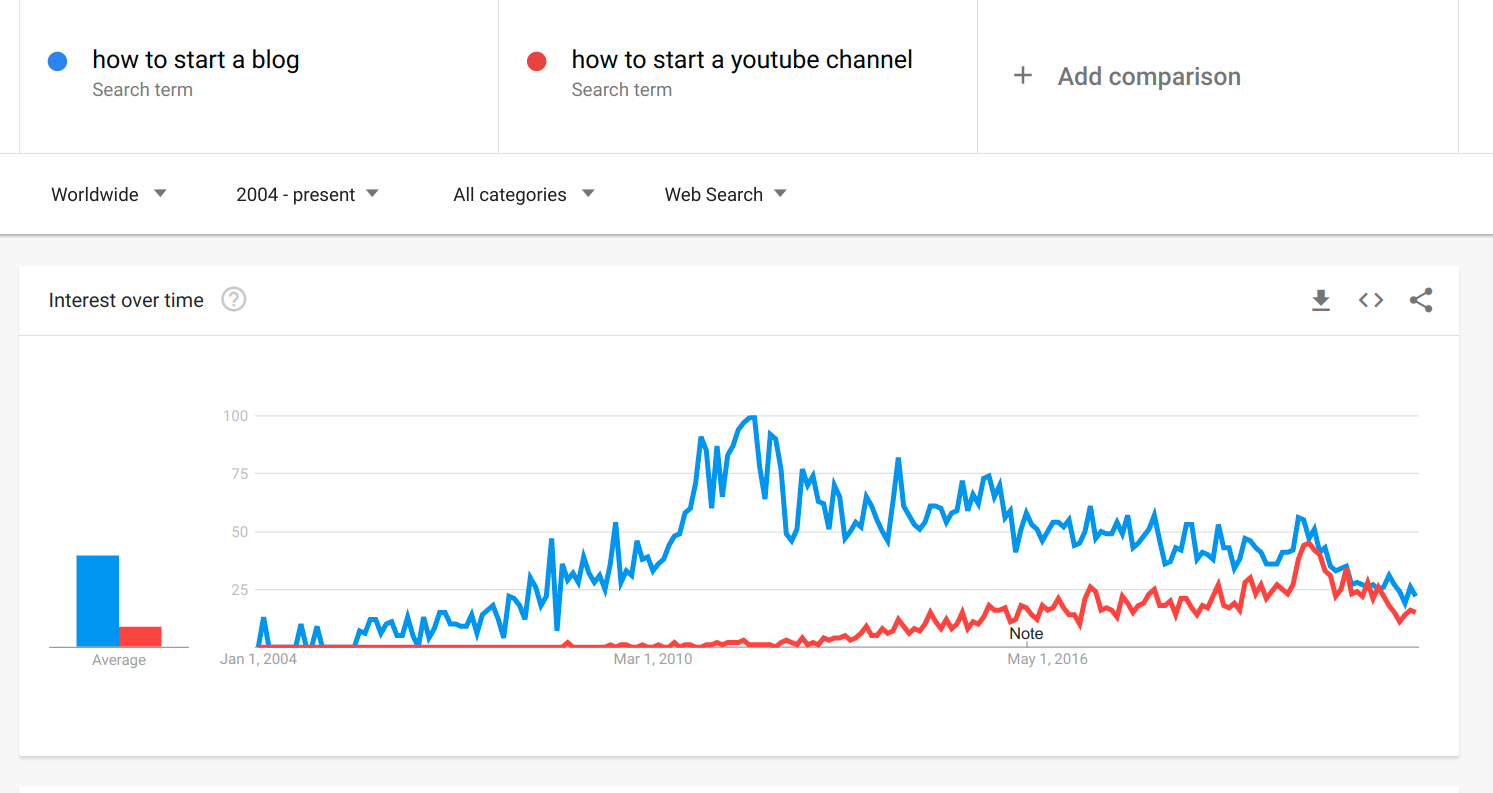This article may contain affiliate links. If you buy some products using those links, I may receive monetary benefits. See affiliate disclosure here
In this day and age when Metaverse is all the hype on the internet, this post may seem outdated.
But is it? New innovations and technologies open new doors. However, it may not always fully replace older ones. Did physical books disappear with the arrival of the World Wide Web? No.
Similarly, I don't think a three-dimensional virtual world will completely replace the existing web.
So, in my opinion, it's never too late to start a YouTube channel or blog. But the question is, which one is better?
In this post, I will discuss some important factors to consider in case you are confused between starting a blog and a YouTube channel.
1. Popularity & Trend
Blogging has been around for so long. It was the hype during the latter half of the 2000s and early 2010s.
But times have changed and some people are even discussing whether blogging is dead or not. Maybe, personal blogging as we used to know it may no longer exist. Platforms like IndiBlogger, which once used to be a favorite hub for personal bloggers, are now shutting down or becoming defunct.
However, one thing you should always keep in mind is that a blog is primarily a way to share content in the form of written text, just like books and newspapers. The only difference is that blogs have a digital presence.
Are people going to stop reading? I don't think so. If you can perceive your blog as a way to share content, then it always has a place. Businesses can use it as a powerful tool for inbound marketing.
My assumption is backed up by this chart from Google trends. Look at the line for the keyword "how to start a blog". It was quite trendy about ten years back and then started declining gradually.
from Google Trends
During that time, YouTube was gaining popularity. Both the lines converged just after 2020. Now, both seem to have the same level of popularity post-2020, with blogging having a slight edge, although negligible.
So, according to current situations, I hope both blogging and YouTube are here to stay.
2. Skills Required
Basic Knowledge
Be it with a blog or YouTube, having a good deal of knowledge in your particular niche is quite important.
Because to share some knowledge, you should first possess that knowledge.
So, the first step is to find out what you are already good at.
I am not saying that you need to be an expert before starting a blog or a YouTube channel. You can also take the grow with me approach, where you share your journey as you learn the topic.
For instance, if you are not a gardener but want to create a blog/vlog about gardening, then you can try to grow a garden at your home while sharing your experiments along the way.
The technical skills required for blogging and vlogging are totally different. If you are confused about whether to start with a blog or YouTube, then it's necessary for you to assess your skillset to make the right decision.
First, let us check the requirements for blogging.
Technical Skills for Blogging
As I have mentioned in the introduction, the written content is the king when it comes to blogging. So the first and foremost skill required for blogging is the ability to write engaging content.
For most people, this comes naturally. If not, you can try out some copywriting and content writing tutorials online.
Next, you should have a basic understanding of how websites work. Because in the end, a blog is also a website. To get it up and running, you need to purchase a domain name, connect it to the hosting provider, etc.
Basic graphic designing and branding skills can help make your blog look professional. You don't need to be a Photoshop expert, but learn to create thumbnail images, set suitable fonts, colors, etc.
An online graphic designing tool like Canva can be sufficient for most design-related purposes.
To really make your blog successful, you need to know digital marketing and SEO as well. Learn keyword research, competitor analysis, and tools like Google Search Console and Google Analytics.
Skills for YouTube
Skills required for creating a YouTube channel can vary depending on the type of videos you want to create.
For instance, if you want to show your face in the video, then you have to be confident talking in front of the camera. Not everyone feels comfortable in front of a camera.
But there are also several YouTube channels that do not reveal the face of the creator at all. Most of these are animation-style videos.
Having a solid knowledge in videography, such as the different camera angles, lighting, etc can really help to improve the quality of your videos.
To create such high-quality videos, you should be good at video editing too. Although you don't need to know how to create those fancy effects, you should learn at least some basic video editing. Davinci Resolve is an amazing free video editor, which offers advanced features.
Next is communication skills. Whatever topic you are sharing, try to present it in an engaging manner. Otherwise, people can easily get bored and skip the video.
Even if you are not showing your face in the video, give the voiceover in an interesting way so that the user feels that they are hearing a story. Try adding B-rolls at relevant points to make it more interesting.
Now, some of you might be thinking, "I am an introvert, this is not for me". Don't take it like that.
In many cases, people who talk less, talk effectively.
Personally, I prefer videos where people talk in a calm and composed way.
You can even find YouTube as a way to improve your communication skills, which can help in other areas of life as well.
Another thing is the language in which you want to make the videos. If you have a good local audience, then do the videos in your mother tongue. Otherwise, if you want to target everyone, then the videos should be in English.
Thumbnail images are more important for YouTube videos than for blog posts. Because it is the most important factor that affects the click-through rate when a video appears in the suggestions. So, learn the ins and outs of creating attractive thumbnail images.
Finally, learn the basics of video SEO, keyword research, adding tags, etc. There are several tools like Tubebuddy to make your job easier.
3. Cost
The next question is, which is more expensive - a blog or YouTube channel?
Let me tell you about blogging first. To create a website or a blog you need a domain and hosting. A domain usually costs around $10 per year while the cheapest hosting can be somewhere around $5 to $10/month.
Later, as your blog starts receiving a lot of traffic, you might want to upgrade to a higher-end VPS, cloud, or a dedicated server that costs tens or even hundreds of dollars per month. However, a cheap shared hosting plan is enough to get started.
In addition to that, you also need a laptop or desktop computer along with a good internet connection.
- Domain name
- Web hosting
- Laptop or desktop
- Internet connection
When it comes to YouTube, the platform is free. You don't need to buy the domain name or hosting space.
But there are other costs involved. These days mobile phones come with decent cameras so that you can start recording your videos right away.
Later you can consider buying a camera which can really improve the quality of the videos.
Audio is another area that beginners often overlook. It will be better if you can afford a good quality lavalier microphone. Or if you are recording from a desktop computer, then you should get a decent USB microphone.
For blogging you need only a basic laptop or desktop computer that can access the internet. But that's not enough for editing videos. You need at least a medium spec computer, preferably with a GPU.
Advanced video editing software like Adobe Premiere and Davinci Resolve requires medium to high end systems to work smoothly.
- Microphone
- Camera or mobile phone to record video
- Laptop or desktop with good specs (if using Adobe Premiere or Davinci Resolve. There are also cheaper alternatives like Filmora and Movavi).
Overall, the initial cost of starting a YouTube channel is more than that of a blog.
4. Which is Easier to Get Started
Again it depends on the skills you have and the budget you can afford.
If you are not confident in your communication skills, then blogging may be easier to get started. Because if you are not happy with the sentence or phrase, you can easily press the Backspace or Delete key and rewrite it.
Whereas for video, cutting out the wrong portion and then rerecording it is more painful.
Writing can also help improve your language, bring clarity to your thoughts, which in turn improves your speaking skills. So later it may give you the confidence to start a YouTube channel.
But for some people, YouTube may be the goal and they are already good at speaking. If you are like that, then there is no need to waste time writing a blog. Instead, start making videos right away.
5. Vlogging vs. Blogging: Content-creation Time
The workflow is quite different for blogging and video creation, which determines the time you take to churn out new content.
- For both blogging for YouTube, you need to do the initial research and make a content outline. From there things begin to diverge.
Blogging involves:
- writing the post,
- proofreading,
- formatting,
- on-page SEO,
- and then publishing it
And it's done. It only takes a couple of minutes or a few hours to write a 1000 to 2500 word blog post. Otherwise, if you want to create a really in-depth article that is 5000+ words long, then it can take a few days or weeks to do the research.
When it comes to YouTube, some people find it quite easy to talk straight to the camera and get it right in a single take.
If the video clips are clear and without any errors, then the editing part becomes easier. The video will be perfect without the need for many cuts.
However, some people find it quite difficult to record a video without a detailed script. If you are going to take that route scripting the entire video word by word, then the process can take too much time.
6. Content Ownership
Another crucial difference between a blog and a YouTube channel is ownership. With a blog hosted on your custom domain, you retain complete ownership over the website and its contents.
Nobody can shut your website down one day. Even if the web hosting provider suspends your account, you can get a new server and point the domain to the new location. Or if somebody hacks your website, you yourself can restore it without the help of others.
But that's not the case with a YouTube channel. You have to strictly adhere to YouTube policies. Otherwise, your channel can get suspended, destroying all the hard work.
There is also a chance to get community and copyright strikes from other users or viewers, which makes YouTube think that your channel is not a good fit for their platform.
Also, recovering a hacked YouTube channel can be more tedious than recovering a blog, because you need the help of someone from YouTube to do that.
7. Updating Content
Updating existing content is as important as publishing new content to keep your blog or YouTube channel up to date and relevant with new information.
Since the blog is mostly textual content, you can easily open the text editor and rewrite the necessary part to update it.
Or if you want to keep the older version, you can also clone a new draft from the older post, make the necessary changes, and publish an updated version.
For instance, you have a blog post about the best mobile phone cameras, published in 2021. In the next year, i.e. in 2022, you'll want to publish an updated version of that post.
Some of the items in the list may remain the same as the previous year. So you may not need to rewrite the whole post. Instead, you can clone a new draft from the 2021 post, add new phones, delete outdated ones, and publish it as a new post.
But in the case of video, that type of editing is not practical. You cannot take the old video, cut out the irrelevant parts, and add new frames. It can end up looking quite unnatural.
In short, the only way to update old video content is to rerecord it.
8. Growing Traffic: Promotion, SEO, and others
Growing traffic for a blog is not an easy task.
In the short term, you can try things like PPC advertising & social media. But to build traffic in the long term, you need to take SEO seriously.
And that includes several things. Publishing a couple of posts is not enough to attract a considerable amount of traffic.
Most blogs witness significant growth in traffic once they’ve published at least fifty posts. In addition to that, you also need to invest time in doing on-page and off-page SEO, which includes several strategies like link building.
Depending on your audience, you may also want to try other things like building an email list to retain more visitors.
In comparison, growing traffic on a YouTube channel is much easier. Since YouTube is such a popular platform, you can easily get that initial reach via suggestions and searches.
Chances are higher for your videos to go viral on YouTube. So even with just 10 or 20 videos your channel can take off.
Compared to blog SEO, YouTube SEO is a lot simpler. Yes, you still need to know how to craft catchy titles, create attractive thumbnails and add some video tags.
But from there, YouTube takes care of the rest. You only need to focus on producing quality videos.
9. Monetization Methods
Both blogs and YouTube channels open doors for diverse monetization techniques.
For a blog you can try the following things:
- Affiliate marketing: Promote products from others and earn a commission
- Sell digital products: You can create your own digital products such as ebooks, software, etc and sell it on your site.
- Advertisements: Join an advertisement network and place ads on your site. Google AdSense is one of the most popular. There are also other alternatives like media.net and Propeller Ads. If you have a high traffic blog, you can also directly sell advertisement spaces to potential buyers.
- Online courses: If you have a specific skill, you can also set up an e-Learning platform along with your blog to create an extra stream of revenue.
Similarly, with YouTube also you can try different monetization methods:
- YouTube Partner Program: Ability to place advertisements in your videos and earn money.
- Sponsorships: If you have a good enough audience, then brands may contact you directly and ask to promote them in your videos. Sponsorship have the potential to become lucrative.
- Affiliate marketing: You can promote relevant affiliate products in your videos and leave a link to them in the description.
10. Which is faster to start making money
This question has no definite answer because it depends on a lot of factors such as your niche, experience, and how many hours you are willing to put in.
If you start blogging with a clear plan to profit, then you should be able to generate income within one year.
In my experience, I was able to generate some affiliate sales after about one year from starting the blog. Note that I was not an experienced content writer then. So my posting frequency was not that good.
But if you are good at content writing and able to churn out new posts every day or at least on alternative days, then you should see the results sooner.
Compared to that, I would say that YouTube channels are much easier to get that initial traction. I know many channels that have skyrocketed with fewer than 50 videos.
But with persistence, both have great potential to earn you money.
11. Which is Easier to Sell: Blog / Youtube
Some people say that it is against the YouTube terms and conditions to sell a channel while other sources assert that you can do so without any issues.
Also, many popular YouTube channels got sold for millions of dollars in the past (like this one).
But there are other concerns you need to think of.
For most YouTube channels, the content creator (that is you) is the icon of the channel. People subscribe to your channel because they want to watch you. So the subscribers may get disappointed when they find that you are no longer running the show.
But a blog has a less personal touch, which works as a blessing in disguise when you want to sell it off. There are many marketplaces like Flippa and Sedo, where you can sell online businesses including blogs.
12. Difference in Audience
The scope of video content is much larger than written blog posts. Because video has a higher potential to reach a wider range of audiences.
For instance, you can use a YouTube channel to run a television show. There are many television channels that cross-post their entertainment programs on their official YouTube channels in addition to telecasting.
There are also YouTube channels that share informative and educational content just like on blogs.
In short, YouTube can hold a broader spectrum than a blog. It can be educational, journalism, comedy, entertainment, technology, or anything in between.
13. Long-term Commitment
If you stop posting new videos on a YouTube channel, people will soon assume that you have abandoned it. They will start flooding your comments section with questions about your absence.
But a blog does not need that kind of commitment. Again, its lack of personal touch comes as an advantage. Even when you have no new posts to publish, you can keep it running by updating old posts.
14. Doing Both
It need not always be Blog vs. YouTube. You can also do both of them if you have the time and resources.
But for most people who are starting out, running both of them side-by-side can be overwork.
That’s why most people start with a blog. Later you can repurpose the content into video and publish it on YouTube.
Conclusion
I hope this post helped you to understand the nuances of running a YouTube channel or a blog.





![5 Best Video Hosting Sites [for Businesses & Educators]](https://cdn-2.coralnodes.com/coralnodes/uploads/medium/2021/10/video-hosting-sites-featured-1.jpg)
![How to Embed Videos in WordPress [Different Methods]](https://cdn-2.coralnodes.com/coralnodes/uploads/medium/2021/10/embed-videos-wordpress-featured-1.jpg)